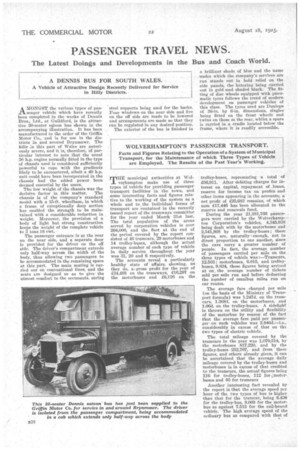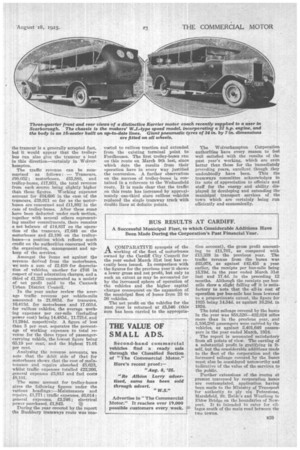WOLVERHAMPTON'S PASSENGER TRANSPORT.
Page 22

Page 23

If you've noticed an error in this article please click here to report it so we can fix it.
Facts and Figures Relating to the Operation of a System of Municipal Transport, for the Maintenance of which Three Types of Vehicle are Employed. The Results of the Past Year's Working.
MLLE municipal authorities at Wel
verhampton make use of three types of vehicle for providing passenger transport facilities in the town, and some interesting facts and figures relative to the working of the system as a whole and to the individual forms of transport are contained in the recently issued report of the tramways committee for the year ended March 31st last. The total population of the areas served by corporation vehicles is over 264,000, and the fleet at the end of the period covered by the report consisted of 46 tramcars, 29 motorbuses and 14 trolley-buses, although the actual average number of each type of vehicle in daily service throughout the year was 31, 20 and 6 respectively. The accounts reveal a particularly healthy state of affairs, showing, as they do, a rgross profit for the year of 134,488 on the tramways, 116.297 on the motorbuses and 16,126 on the trolley-buses, representing a total of 156,911. After debiting charges for interest on capital, repayment of .loans, reserve for income tax on profits and other items appearing in the accounts, a net profit of 125,682 remains, of which sum 117,446 has been allocated to the reserve and renewals fund.
During the year 21,381,766 passengers were carried by the Wolverhampton Corporation's vehicles, 4,345,938 being dealt with by the motorbuses and 2,541,808 by the trolley-buses ; these figures, are, naturally enough, not in direct proportion to one another, since the cars carry a greater number of people. In fact, the average number of passengers carried per mile on the three types of vehicle was :—Tramcars, 12.503; motorbuses, 6.015, and trolleybuses, 9.824, these figures being arrived at on the average number of tickets sold per mile run and before deducting the number of omnibus miles run on car routes.
The average fare charged per mile (on the basis of the Ministry of Transport formula) was 1.247d. on the tramcars, 1.368d. on the motorbuses, and 1.06d. on the trolley-buses. A sidelight is thrown on the utility and flexibility of the motorbus by reason of the fact that the average fare paid per passenger on suoh vehicles was 2.846d.—i.e., considerably in excess of that on the two types of electric vehicle.
The total mileage covered by the tramcars in the year was 1,070,514, by the motorbuses 817,220, and by the trolley-buses 252,767, and from these figures, and others already given, it can be ascertained that the average daily mileage covered by the trolley-buses and motorbuses is in excess of that credited to the tramcars, the actual figures being 116 for trolley-buses, 112 for ,-nioterbuses and 95 for tramcars
Another interesting fact revealed by the report is that the average speed per hour of the two types of bus is higher than that for the tramcar, being 8.436 for the trolley-bus, 8.009 for the motorbus as against 7.513 for the rail-bound vehicle. The high average speed of the malinary bus as compared with that of
the tramcar is a generally accepted fact, but it would appear that the trolleybus can also give the tramcar a lead in this direction—certainly in Wolverhampton.
The traffic revenue can be summarized as follows — Tramcars. £98,052 ; motorbuses, £55,888, and trolley-buses, £17,951, the total revenue from each source being slightly higher than these figures. Working expenses account for /64,606 in the case of the tramcars, £39,911 so far as the motorbuses are concerned and £11,892 in the case of trolley-buses. After these sums have been deducted under each section, together with several others representing smaller commitments, there remains a net balance of £14,837 on the operation of the tramcars, 17,648 on the motortnises and £3,196 on the trolleybuses—a position which reflects much credit on the authorities concerned with the organization, management and upkeep of the services.
Amongst the items set against the revenue derived from the motorbuses, we note a sum of 12.410 for depreciation of vehicles, another for 1745 in respect of road adaptation charges, and a third of 11.252 enumerated as a moiety of net profit paid to the Cannock Urban District Council.
In the year under review the average traffic revenue per vehicle-mile amounted to 21.9834. for tramears, 16.413d. for motorbuses and 17.0.514. for railless vehicles, the average working expenses per car-mile (including power cost) being 14.483d., 11.7214. and 11.294d. respectively. A figure of less than 5 per cent, separates the percentage of Working expenses to total revenue for the three types of passengercarrying vehicle, the lowest figure being 65.19 per cent and the highest 71.01 per cent.
Analysing the revenue accounts, we note that the debit side of that for motorbuses shows that the cost of maintenance and repairs absorbed 15,623, whilst traffic expenses totalled £22,266, general expenses £3,018 and fuel costs £8,101.
The same account for trolley-buses gives the following figures under the various headings :—Maintenance and repairs, £1,771; traffic expenses, £-6,014; general expenses, 12,246; electrical power purchased, 11,842.
During the year covered by the report the Bushbuty tramways route was eon
verted to railless traction and extended from the existing terminal point to Fordhouses. The first trolley-buses ranon this route on March 9th last, since which date the results from their operation have in every way justified the conversion. A further observation on the success of trolley-buses is contained in a reference to the Weduesfield route. It is made clear that the traffic on this route has increased by approximately one-third since railless vehicles replaced the single tramway track with double lines at definite points.
The Wolverhampton Corporation authorities have every reason to feel well satisfied with the results of the past year's working, which are even better than those for the immediately preceding years, excellent though they undoubtedly have been. This the tramways committee acknowledges in its note of appreciation to officials and staff for the energy and ability displayed in developing and extending the municipal transport services of the town which are certainly being run efficiently and economically.




























